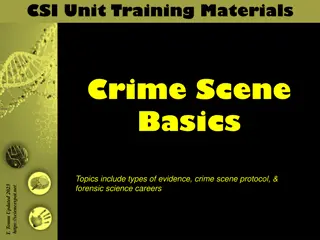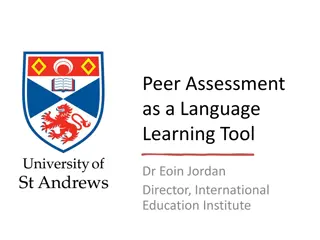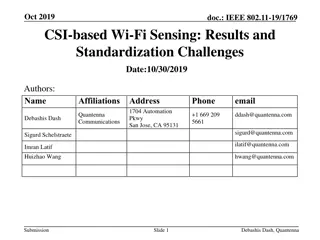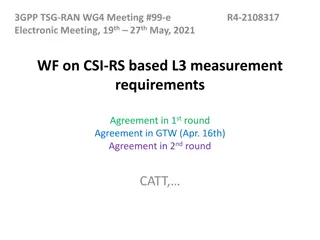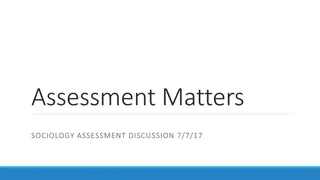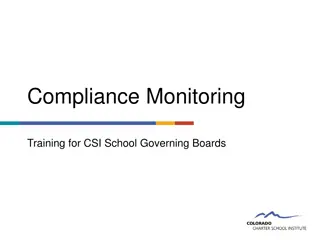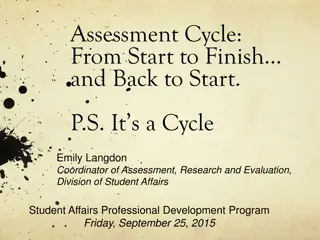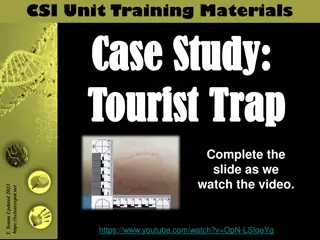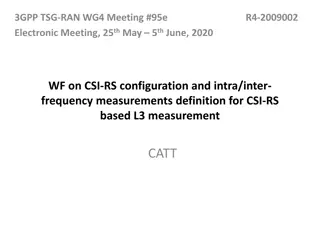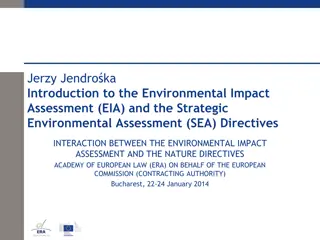Language Matters CSI assessment
In this task, students will create an infographic promoting the use of language that builds confidence, trust, and self-esteem in diabetes care. Drawing from workshops and discussions, the infographic aims to engage medical students or health professionals by showcasing key messages and overcoming barriers to effective communication. Annotations will articulate the rationale behind message selection and barrier mitigation, emphasizing collaborative self-care approaches and behavior change strategies.
Download Presentation

Please find below an Image/Link to download the presentation.
The content on the website is provided AS IS for your information and personal use only. It may not be sold, licensed, or shared on other websites without obtaining consent from the author.If you encounter any issues during the download, it is possible that the publisher has removed the file from their server.
You are allowed to download the files provided on this website for personal or commercial use, subject to the condition that they are used lawfully. All files are the property of their respective owners.
The content on the website is provided AS IS for your information and personal use only. It may not be sold, licensed, or shared on other websites without obtaining consent from the author.
E N D
Presentation Transcript
Language Matters CSI assessment March 2022 March 2022 Student Name: Student Name: Student CID: Student CID:
Preparatory Reading You may find that these readings help you in your assessment: NHS Language Matters guidance https://www.england.nhs.uk/wp-content/uploads/2018/06/language-matters.pdf https://anniecoops.com/2017/06/28/languagematters/ https://www.sixuntilme.com/blog2/2011/09/25_years_with_diabetes_what_iv.html Changing the Conversation video (at the bottom of the webpage) https://www.diabeteseducator.org/practice/educator-tools/app-resources/diabetes-language-paper
Instructions Drawing on your work in the Language Matters Diabetes Forum on 14th January, your group will need to choose a specific target audience of medical students or health professionals and create an infographic aimed at them to promote the use of language that builds confidence, trust and self-esteem and fosters a collaborative approach to self-care in relation to diabetes. Your audience should be specified and can be medical students or a specific group of health professionals e.g., doctors in training, GPs, school nurses etc. Your poster should demonstrate engagement and reflection on the activities undertaken during the Language Matters Diabetes and the Quality Improvement workshops. Also consider your use of visuals (both images and your style of infographic design) to engage your target audience. Tasks: Create your Language Matters infographic on page 3 in this document and copy it onto pages 4 & 5. On page 4 annotate the infographic using the speech bubbles to demonstrate the key messages chosen and the thinking and rationale behind the choice of those specific messages for your target audience with reference to the learning from the workshop. On page 5 annotate the infographic using the speech bubbles to demonstrate the barriers to reaching the target audience and how you have overcome these barriers in the design of your infographic demonstrating the thinking and rationale behind the barriers mentioned with reference to the learning from the workshop. You may also consider the challenges of being able to effect behavioural change thinking about motivation, the process of change and how these challenges may be met. Please look at the marking proforma for this assessment which outlines how this infographic will be assessed
Infographic Annotations Infographic Annotations Key Messages Use the speech bubbles to annotate the infographic to explain the key messages that you have chosen and to explain your think Use the speech bubbles to annotate the infographic to explain the key messages that you have chosen and to explain your thinking to why these messages were chosen to reach your target audience. Write as much text as you feel you need in the bubbles to ar to why these messages were chosen to reach your target audience. Write as much text as you feel you need in the bubbles to artic justifications. Add more bubbles if you feel that you need them. justifications. Add more bubbles if you feel that you need them. Key Messages ing and rationale as and rationale as ticulate your ulate your
Wording Used Infographic Annotations Infographic Annotations Wording Used Use the speech bubbles to annotate the infographic to describe the barriers that you can identify in reaching your target aud Use the speech bubbles to annotate the infographic to describe the barriers that you can identify in reaching your target audien infographic has overcome these barriers to engage them in behavioural changes that result in more collaborative language and infographic has overcome these barriers to engage them in behavioural changes that result in more collaborative language and int patients with diabetes. patients with diabetes. Write as much text as you feel you Write as much text as you feel youneed in the bubbles to articulate your justifications. Add more bubb need in the bubbles to articulate your justifications. Add more bubbles if you feel that you need them. you need them. ience and how your ce and how your interactions with eractions with les if you feel that
Y1 CSI TBL tApp Group Infographic Assesment Form Language Matters Total Marks Below Meets Above Expectations 4 Expectations 1 Borderline 2 Expectations 3 Outstanding 5 SLIDE 5 Key Messages 1. Visual depiction of key messages 5 Visual tools do not convey the key messages to target audience. Poorly laid out. Multiple typographical or formatting errors or poor readability. Reasonable looking poster however the visual tools do little to reinforce the key messages. Some typographical or formatting errors. Use of layout, icons/images and font is visually engaging but also aligns with key messages. Readability could be improved in places. Infographic demonstrates attention to detail and presentation. Use of layout, icons/images and font is very visually engaging but also aligns with key messages. The infographic demonstrates close attention to detail and presentation. It immediately attracts attention with a high level of readability. Excellent use of layout, icons, images and font which is highly visually engaging and reinforces key messages. The visual presentation is professional and sophisticated. The infographic was visually engaging. Messages were well presented with good readability. 2. Articulation of key messages chosen 5 Up to 3 messages but with little relevance to a Language Matters campaign. No clear target audience identifiable. Little or no demonstration of understanding of the impact of language on people with diabetes and confidence and ability to self-care. Little or no 2-3 messages but with weak/indirect relevance to a Language Matters campaign. Target audience identifiable but messages of little relevance. Understanding of the impact of language on people with diabetes and confidence and ability to self-care inconsistently 2-3 messages clearly relevant to Language Matters campaign. Target audience identifiable and messages clearly relevant to this audience. Demonstrates good understanding of the impact of language on people with diabetes and confidence and ability to 2-3 messages very relevant to a Language Matters campaign. Target audience identifiable and messages very relevant to this audience. Messages demonstrate creative thinking (i.e. go beyond messages in preparatory reading material). Demonstrates 2-3 messages very relevant to a Language Matters campaign. Target audience identifiable and messages highly relevant to this audience. Messages demonstrate original and creative thinking (i.e. go beyond messages in preparatory reading material). Demonstrates The infographic identifies 2 3 pertinent messages in relation to promoting better communication with people with diabetes and about diabetes. The messages demonstrate an understanding of the learning covered in the Language Matters Diabetes Workshop













